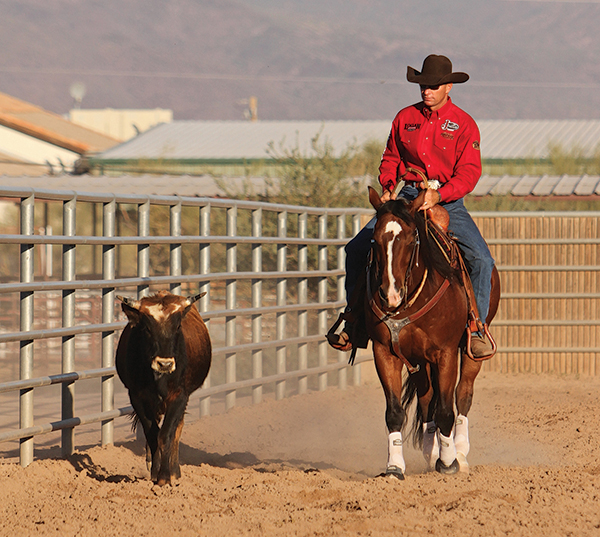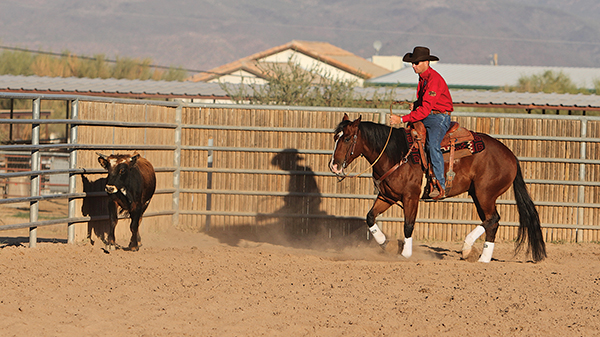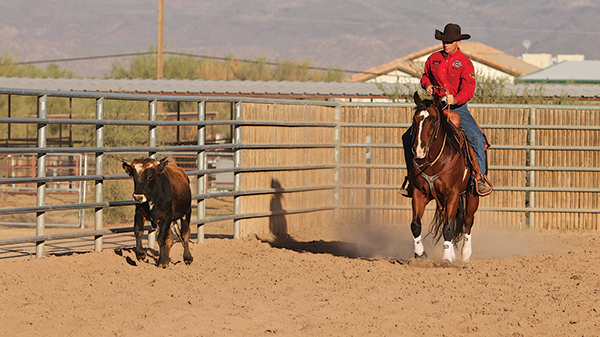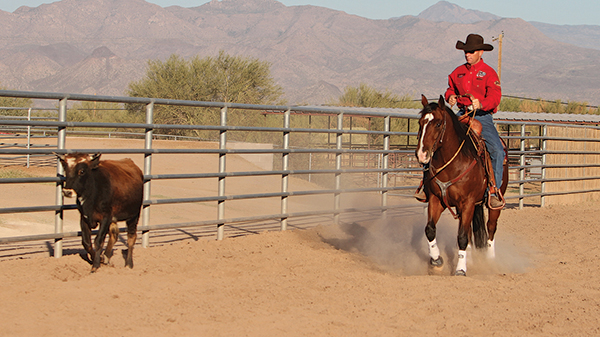Q I’ve been competing in the boxing classes at breed shows and NRCHA events for 18 months. I’m ready to add fencework to my skill set so I can compete in more advanced classes. My horse has some previous experience on the fence with his past owner, but I’ve never gone down the fence. How do I start so that both my horse and I build our confidence to eventually make fence turns and circle up?
[MORE WITH BRAD: NEW-HORSE CHECKLIST]

June Fischer, Louisiana
A It sounds like you have the right approach to learning fencework—taking your time and building your confidence. This mindset will also help keep your horse from developing bad habits, such as getting pushy or even charging when you bring the cow through the corner after for fencework.
The exercise I’ll outline here is excellent for beginners, but it’s also something I use with my open horses and have my experienced non-pro riders use when a horse wants to rush out of the corner to the first fence turn. A horse that charges through the corner can be dangerous due to the lack of control. An experienced cow horse knows that the fun part of his job is coming, and he can get strong because he wants to get to working the cow. Riders can get nervous through the corner, too, which translates to the horse and makes him edgy. This drill slows everything down so horse and rider have time to think and plan their next move.
‘Beginner’ Cattle
Because you’re a beginner at fencework, if you have a variety of cattle, choose cows that are on the docile side so you can keep the speed down. This lets you plan adjustments and keeps you safely under control. (Or gives you a better chance at being in control—if your horse isn’t well-broke, you need to work on that before you chase a cow down the fence.)

Sometimes, however, you have to work the cows you have, even if they’re not “beginner” cattle. Knowing that your horse is broke and responsive means you’ll have confidence to stop him anytime, whether it’s one stride out of the corner if your horse gets pushy or two-thirds of the way down the arena, where you’ll want to stop in this exercise.
Box on the Long Fence
You’ve said your horse is proficient at boxing (taking the cow back and forth along one of the short end of the arena, stopping with the cow, and traveling with it when it moves), so try boxing on one of the long sides of the arena. It’s not about running fast and getting close to the cow. Instead, focus on getting comfortable with the space necessary between your horse and the cow so that you and your horse dictate the cow’s moves. I call this space “depth.” The closer you are to the cow, the more it wants to run down the fence, away from the horse. Stay anywhere from 3 to 20 feet from the cow so that there’s no doubt that the horse is pushing the cow down the fence, but without too much pressure. This generally keeps the movement slower and allows you more time to make decisions. Decision-making tends to get rushed with speed, and that can let things get out of hand in a hurry, not to mention teaches your horse to rush and charge. If the cow does come off the fence, get behind it at a safe speed and track it to the end or one of the long fences. It’s about staying in position, not about staying on one side of the fence. Once you feel proficient boxing the cow on the long fence, take it back to the short fence for the next step.
Track and Stop
Track your cow back to one of the short sides of the arena. At the middle of that arena fence, position your horse’s nose at the cow’s hip or middle rib to apply enough pressure to push the cow forward, close to the fence, but you stay back enough that the cow sees it can go forward as its way out. If you’re too close to the cow’s head, you shut that door, and if you’re too far away, the cow can do whatever it wants. Forward motion at the proper distance keeps you safe and in control. I want to stress that you don’t start this exercise from the corner. Set up your horse in the middle of the short fence so you have forward motion to go through the corner in one movement. If your horse gets strong going through the corner, or at any point going down the fence, stop him and turn into the fence. This keeps your horse listening to you rather than just chasing the cow.
[MORE WITH BRAD: SAFETY WHILE CIRCLING A COW]

As you push through the corner, be aware that you do have to push the cow. Even if it’s a faster cow, you have to drive it where you want it to go. Waiting for the cow to find its way forward out of the corner can create a blastoff effect for your horse where he bursts forward to try to catch up. This can get scary and compromise your safety. Drive from the cow’s middle rib to push it forward.
Move down the fence with the depth I mentioned earlier, staying about 3 feet away from the cow to the inside of the arena. If you’re too far behind the cow, it allows the cow to come off the fence in front of your horse, which is unsafe and means you lose control of the cow. If you’re too far up the cow’s body, the cow won’t move. Stay at the cow’s hip or ribs to keep forward motion and control.
Track the cow two-thirds of the way down the fence; come to a complete, square stop; and back your horse a few steps. Allow your horse to settle while the cow continues forward to the end of the arena you were traveling toward. Then jog or quietly lope your horse to catch up with the cow, drive him through the next corner, and take him down that fence. Pick up your position; get your depth, rate, and speed; and stop two-thirds of the way down the arena again.

Use This Drill Regularly
Even when you start making fence turns and circling up, keep this exercise as part of your training toolbox. An experienced cow horse knows when the speed is coming, and he’ll anticipate it. You can slow things down and keep your horse under control by working through this drill on a regular basis to prevent charging or break the bad habit if it develops.
[MORE WITH BRAD: 5 THINGS I LEARNED RIDING WITH BRAD BARKEMEYER]






